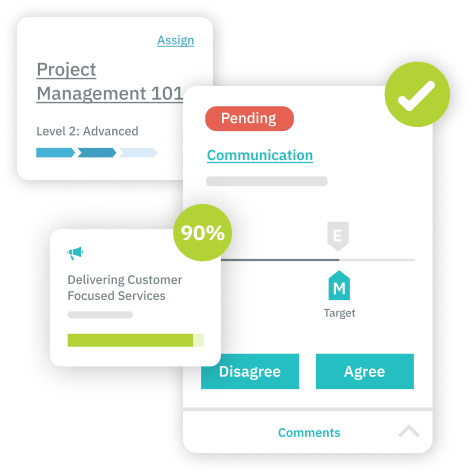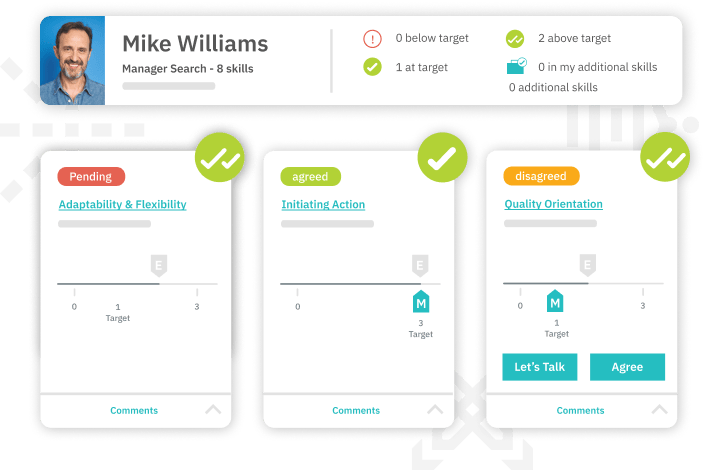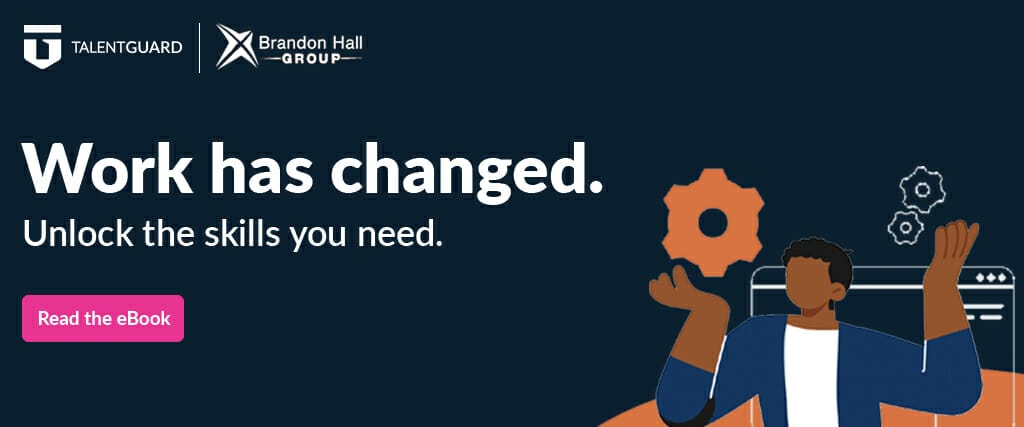
Skill Inventory Software
Know exactly what your people can do
Our platform provides the skills inventory software you need to deploy tailored job-based assessments that measure the skills most relevant to an employee’s role, according to your career architecture. Learn exactly what your employees can do so you (and they) can apply their talents now and plan their future development.


Gap analysis
Assess the gaps between your employee’s current skills and the targeted skill benchmarks to accomplish organizational goals.

Unbiased skill verification
Assess, rank, and verify skills to understand gaps between self-perception and manager ratings. Identify ingredients for alignment, feedback, goal setting, and development.

Curated Learning Plans
Understand your employees’ strengths and gaps so you can direct their professional development based on where they are, where they’d like to be, and what your company needs.

Documented new skill development
When employees learn new skills, they can document their achievements, request feedback from their manager, and track their progress toward development goals.
A talent strategy that grows with you. Select a bundle to get started!
Automate
Create skill profiles, create detailed job descriptions, align learning content with specific skills, and chart clear career path progressions to set the foundation for effective talent management.
Automate includes:
- Create Skill and Competency Profiles
- Develop Job Descriptions
- Map Learning to Skills and Competencies
- Map Career Path Progressions
Assess
Effectively assess their employees’ skills, identify gaps, and implement strategies to develop a skilled and competent workforce prepared to meet current and future challenges.
All the Automate features plus the ability to:
- Create a Skills Inventory
- Conduct Gap Analysis
Engage
Organizations can significantly enhance their talent development strategy and workforce effectiveness by assessing employee skills, curating personalized learning paths, recommending appropriate career paths, and tracking career goals.
All the Automate features plus the ability to:
- Assess Employee Skills and Competencies
- Curate Personalized Employee Learning Paths
- Recommend Employee Career Paths
- Track Career Goals
Optimize
Building talent pools, measuring employee performance, tracking certifications, and conducting multi-rater feedback enhance talent management, ensure compliance, and foster organizational leadership development.
All the Engage features plus the ability to:
- Build Talent Pools
- Measure Employee Performance
- Track Employee Certifications
- Conduct Multi-Rater Leadership Feedback
Trusted by:




Your workforce is changing. Never be unprepared again.
Read our eBook
Additional information
There are a lot of different resources that a company must manage for success. You need to understand your cash flow, assets, investments, and much more. The most significant resource that is often overlooked, however, is your workforce.
Your employees are the backbone of your business. There is no product or service to manage or produce without the help of employees. You maximize your business’s potential by getting the most out of your employees. One of the best ways to do this is using a skills inventory.
What is the purpose of a skills inventory? A skills inventory is a record of all the skills, knowledge, and experience contained by your workforce. So, among all your employees, a skill inventory tracks all of their competencies, so you have a clear picture of the strength of your workforce. Many businesses may do this without active acknowledgment of the practice. You may have a list of employees that you know you can count on for certain jobs. This is a common skill inventory example.
However, as companies get bigger, skills get more complex, and scope expands, keeping track of this becomes more difficult. Accurately keeping track of your skill inventory can mean a lot for your company’s productivity. As you scale, it becomes important to understand the depth of skills and how to nurture them for continued success.
For businesses looking to improve their skill inventory management, the question then becomes how to efficiently take inventory of your skills. Like with most innovations in the modern business world, the answer comes from software solutions. With skill inventory software, you can generate invaluable data that helps you understand the full potential of your workforce. Being able to see the full possibilities of your employees – their skills, credentials, performance scores, and more – will lead to you better allocating their expertise in the workplace. This can also help you identify skill gaps and remedy any concerns with focused HR strategies.
When you know how capable your employees are, you can feel more comfortable organizing projects. When you know their weaknesses, you can identify opportunities to offer training and support. If you’re looking to expand but find some skills underrepresented, you can offer training or adjust your future hiring practices.
Skill Inventories and Replacement Charts
Now some businesses may be less familiar with skill inventories but more familiar with an adjacent concept: replacement charts. While skill inventories and replacement charts could be deployed similarly in some scenarios, skill inventories will have more ongoing uses.
So, what is a replacement chart, and how does it differ from skill inventories? A replacement chart is a solution to a pressing employment problem. If you have a vacancy in a key role, you’ll want to consult replacement charts to determine who you can use to fill in the role now. You could also use it to determine a temp or permanent hire decision. Replacement charts in HRM are a more reactive solution. Skill inventories are much more proactive in their approach. Before we dive more into skill inventories, we can also mention another more proactive solution: succession planning.
The difference between replacement chart and succession planning yet again boils down to reactive measures vs. proactive measures. A succession plan is typically put in place much earlier than a replacement plan. With a succession plan, you identify who in your company can fulfill key roles should they become vacant. With this approach, you can start training these people in the roles earlier on, so you are not taken by surprise by a sudden vacancy. The importance of management succession/replacement charts cannot be overstated. Some key roles offer a lot of productivity to your business. If any of these are vacant for too long, you could incur great losses.
Skills inventory, replacement charts, Markov analysis, regression analysis all are types of human resource planning tools. The goal is to understand the history and probability of employee turnover and anticipate them. Skills inventory offers many more capabilities, but could be used for this effect as well.
We’ve given a lot of detail about the application of a replacement chart. With example cases included to help paint the picture, the goal of a replacement chart should be clear. Now, we can talk more in-depth about skill inventories and their uses.
Skill Repository
Skill inventory in HRM is becoming increasingly popular as a proactive tool. Skills inventories (or a skill repository as it is also known) can help businesses understand the full scope of their workforce. Let’s consider an example and compare a skill inventory to a replacement chart.
With a replacement chart, you are reacting to a vacancy in your business and trying to identify who can fill in this position immediately. If no one in your company can be identified, then you may need to seek a temp replacement or ramp up your hiring.
With skill inventories, you are creating an ongoing and developing list of employee competencies. With this method, you can plan rather than respond to issues. With a skill inventory, you can gauge who in your company has the skills necessary to promote into different roles, or even who has aspirations to. This is the power of a personal skills inventory. Example scenarios like this are not a foreign concept, and many businesses will deal with them at some point.
Skills inventory tools have become increasingly complex to help build a complete skill repository. However, even simple tools can go a long way toward providing useful data. A skills inventory questionnaire can help you uncover information such as job aspirations. If you know which employees want to move up in your company, you could look to put them on the right track for training and promotion.
When it comes to the question of how to create a skills inventory, you could consider low-tech and high-tech solutions. In the current business world, the more efficient the better, and efficiency is found in comprehensive software solutions.
Skills Inventory Assessment
Part of developing a skills inventory is using a skills inventory assessment. Skills inventory assessments, much like the questionnaire mentioned earlier, are a way to gain the data you need to build an accurate skills inventory.
Unfortunately, a questionnaire can only go so far. Some employees may be overstating their expertise. Some employees may under share their abilities. Other employees may be unaware of their proficiency. This is why skill inventory in HRM has become an increasingly technology-aided endeavor. Skills inventory assessments are often a combination of self-assessment and guided examination provided by the employer. Companies can get even more specific representations of their workforce’s skill inventory with structured tests designed to evaluate employee skills.
Another important question that needs to be answered when determining your approach to skill inventory is: what is manpower inventory? Manpower inventory includes the cataloging of your employee skills alongside the precise number of your staff. This can provide even more info depending on how well you record and categorize your workforce.
Management inventory in HRM becomes increasingly important as the hierarchy of your business continues to develop and you have more managerial positions for your staff. Management inventory collects skill data but also considers the particular responsibilities of your managerial workers. This can help when scaling up and fleshing out new roles or looking to promote someone to an even more prestigious position.
Depending on the scale of your business, it can become very complex to manage human resource inventory. Example scenarios mentioned above only go so far, as each business will have unique hierarchies and needs. But no matter what business model you have, or what your workforce looks like, managing a skills inventory is an essential responsibility.
HR Planning
With employees being the most crucial resource for businesses, human resources could then be considered the most important department. To better serve the needs of your employees and the needs of your business, you must develop your HR department to better manage forecasting demand and supply of human resource needs. This exemplifies the importance of human resource inventory. In your company, you may already conduct this under the name of a “human resource audit,” but understanding the term skill inventory is important for uncovering more helpful solutions.
When conducting HR audits, you may have previously felt that you were accomplishing the task fairly well, but when you see the result of a proper skills inventory system, you may be shocked. You might ask, where does the information come from that is contained in a human resource inventory? HR planning software focused on this practice offers a wide array of tools to collect and organize accurate skills data.
It is important to identify the best software for managing a human resource inventory. TalentGuard provides the tools, expertise, and powerful software solutions that you need to nurture your workforce. Observe the full scope of your employee base, and produce data-driven strategies to empower your employees and realize their full potential.


